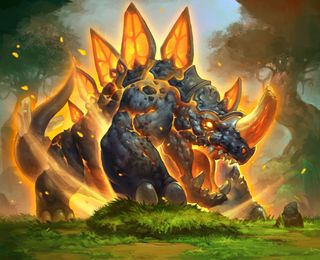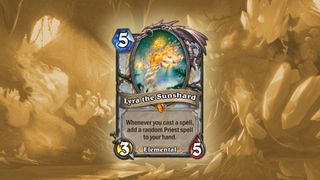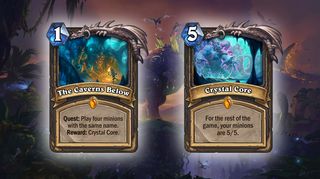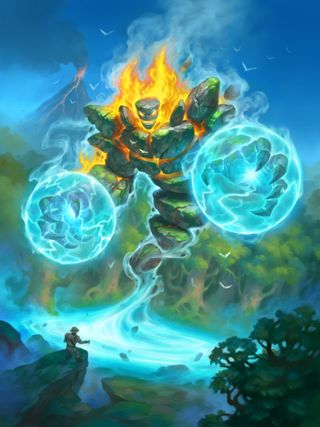
The Hearthstone community is pretty happy right now, and so is Ben Brode. Like the rest of the Hearthstone team, the jovial game director was anxious to see the impact Journey to Un’Goro would have on the meta. And like most players, he’s pretty pleased. Even two months after Un’Goro’s release, Standard is anything but standardized and Wild is nothing if not wild, which is more than could be said for the Mean Streets of Gadgetzan. The Year of the Mammoth is looking good so far, so I caught up with Brode to find out what the rest of it might hold.
PC Gamer: In order of how happy you are with them, how would you rank Un’goro’s big mechanics—Adapt, elementals and quests?

Ben Brode: Adapt, quests, elementals. I really like adapt. It’s a lot of fun. It’s also the kind of fun that we like in Hearthstone, where every game feels different and you’re solving new problems each time. Quests and elementals are really fun, but they’re kind of a strategy that you set up at the beginning of the game, so then the variance in each game and the differences in the problems that you’re solving are based on the decks you’re coming up against and what tweaks you’re making to your deck. Whereas adapt adds new depth to each game.
How do you and the team react when the community completely underestimates the power level of a card, as was the case with Lyra the Sunshard?
I think it’s actually good that this happens, and obviously it happens every time. Part of the fun of a new expansion coming is out is validating assumptions or figuring out what’s good and what’s not good. If it was obvious what was good and was not good, A) we wouldn’t need a balance team and B) it wouldn’t be fun at the beginning of an expansion. You would know immediately by looking at the cards what the best decks were, how they would work and what you should play. But it’s complicated. There are lots of cards, lots of synergies, lots of interactions, lots of decks that other people are playing that change the meta for you. And that makes it fun. That means the meta changes over time, that means you have to figure out what’s good, and that changes also as things about the meta change.

Conversely, when you make a card like Gadgetzan Ferryman, do you plan for it to be more useful down the line, or does it just so happen that some cards become good when new sets are added?
One of the strategies we have when designing cards is to kind of seed the field with things, and then eventually there’s enough pieces that something crazy could happen. We felt like we needed more kinds of cards that bounce things back to your hand and let you play them again before we could get a deck that really focused around that mechanic going.
The biggest gaming news, reviews and hardware deals
Keep up to date with the most important stories and the best deals, as picked by the PC Gamer team.
The Rogue quest is kind of in an interesting spot because it gets way more play than its win rate would suggest it should.
Ben Brode
Sometimes we make a card like Reno and the deck’s good enough. People are going to play it. We don’t need to add a bunch more stuff before that happens. The power level of that card went down a little bit, we did add a couple more cards like that, but we didn’t need to go beyond Kazakus and that one extra tier, sort of as an example, in Mean Streets [of Gadgetzan]. That was good enough for Reno. But sometimes we keep adding cards to an archetype—Silence Priest is another good example—where we knew that the deck was kind of fun to play, it was a really different kind of deck for Priest, so we kept making cards for that deck. We knew we wouldn’t make it with Purify, we knew Purify was not the thing to put that card on the map.
You got some feedback about that card, did you?
[Laughs] Yeah, we got some feedback when we were trying to do that. But yeah, I think if we had put Purify in a bigger set in a time when Priest wasn’t the worst class, that’s exactly the kind of the thing we should be doing. Laying the field with things so that, when we need to later on, we can have a big impact on the meta with just a couple cards changed. Make a Humongous Razorleaf and Shadow Visions, well that’s a big deal for Silence Priest. Suddenly, without very many cards printed, they get to see a brand new archetype that’s pretty competitive that easily.

Speaking of the quests, when you were testing them, were you seeing the Rogue quest get completed as early as turn four or five, as it commonly is on ladder?
You know, I’m not on the final design team, so I wasn’t one of the guys doing that level of play testing. I know they were experimenting with lots of different decks that use that quest, everything from similar builds that we have right now—the Firefly versions—to Coldlight Oracle versions that really duped a lot more card draw. But I don’t know exactly what builds they were playing with.
The Rogue quest is kind of in an interesting spot because it gets way more play than its win rate would suggest it should. Other decks that win as much as the rogue deck does get much less play than the rogue deck does. I think it’s kind of interesting because that deck is very fun to play. It’s more fun to play than other decks of its win rate, and I think it’s less fun to lose to than decks of its win rate. It’s an interesting thing for us to be looking at in general. Why does that deck get more play than other decks of its win rate? Why does it get more play than other decks that are much better than it in win rate?
After each expansion, we publish a list of the 20 Legendaries we recommend crafting. This time around Sunkeeper Tarim came in at number one, which was not really predicted before Un’goro’s release. Could you talk to me about the design of that card and what you were trying to achieve with it?
I think it’s important to have strengths and weaknesses for classes, things that feel like “oh, that’s a Warlock thing” or “that’s a Paladin thing.” And in this case, Paladins are bad at directly destroying other minions, that’s not a strength of theirs. But they have this tricky sort of setting your attack and health thing that they can do both on offense, like buffing their 1/1s, or on defense for weakening enemy minions. I think that’s a play thing that Paladins get to do, they get to be good at that, that makes them fun to play in a different way to other classes.

Sunkeeper Tarim—it’s funny because in some ways he’s very similar to Keeper of Uldaman, right? It’s just that effect, but on everybody. But that actually makes a huge difference, and the fact that he’s a 3/7 Taunt means it actually can trade with three enemy cards on his own. So just the amount of impact he can have on a game unchecked is pretty big. And then also you get to use him sometimes like Bloodlust where you have an army of 1/1 minions that suddenly turns huge. I love that it feels like such a Paladin minion because we’ve been doing so many designs that reinforce what Paladins are good at.

You can find our full list of the top 20 legendary cards in Hearthstone right here.
In terms of class diversity, would you say this is the best meta you can remember?
I think it might be. It’s kind of insane right now. There’s definitely a lot of classes that we’re seeing. You know, there’s always the holy grail of nine classes literally 100 percent equivalent, but I don’t think that’s realistic, right? There’s so many different cards and decks that I think it is a bit of a pipedream to pursue nirvana there. But I do think it’s better than it ever has been, and that’s exciting.
Going into the set release, were you confident this was going to be the case?
We very rarely have confidence in what a meta will look like when a set comes out. We push cards that we think are fun and build-around marrow into a higher power level spot. Sometimes we miss a little bit high on those cards and they’re too powerful, sometimes we miss a little bit low and they’re not as powerful as we wanted and we might support those later on with a couple more designs. But we don’t know for sure, exactly what the 15 best decks are going to be going into a meta. There’s some work involved in that, and there’s a lot of players—there’s a lot more of them than there will ever be balance testers on the Hearthstone team. So it’s hard to have that level of confidence about a meta, but sometimes it just works out fortuitously.
On the next page: The future of the Hall of Fame, the truth of Blizzard’s alleged rotational balance, and what it’s like being the face of Hearthstone…
With over two decades covering videogames, Tim has been there from the beginning. In his case, that meant playing Elite in 'co-op' on a BBC Micro (one player uses the movement keys, the other shoots) until his parents finally caved and bought an Amstrad CPC 6128. These days, when not steering the good ship PC Gamer, Tim spends his time complaining that all Priest mains in Hearthstone are degenerates and raiding in Destiny 2. He's almost certainly doing one of these right now.
Most Popular

